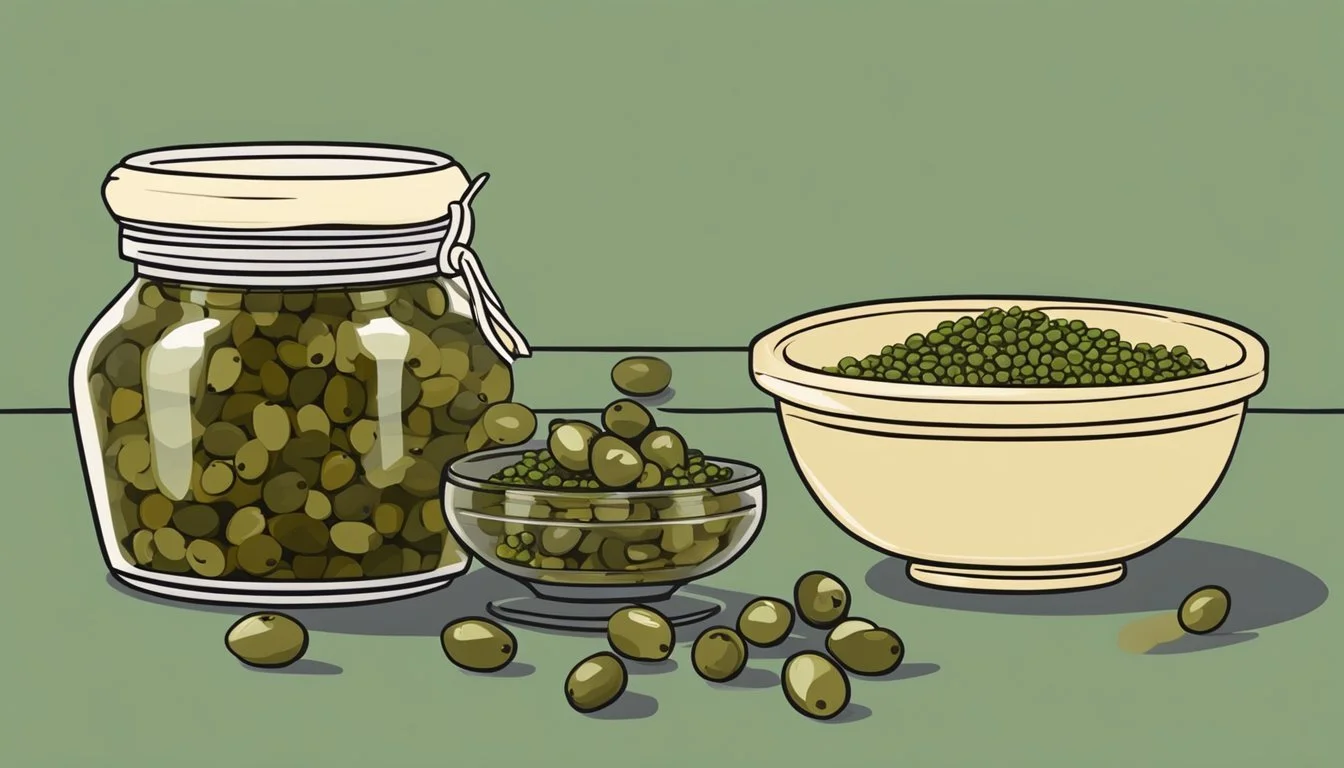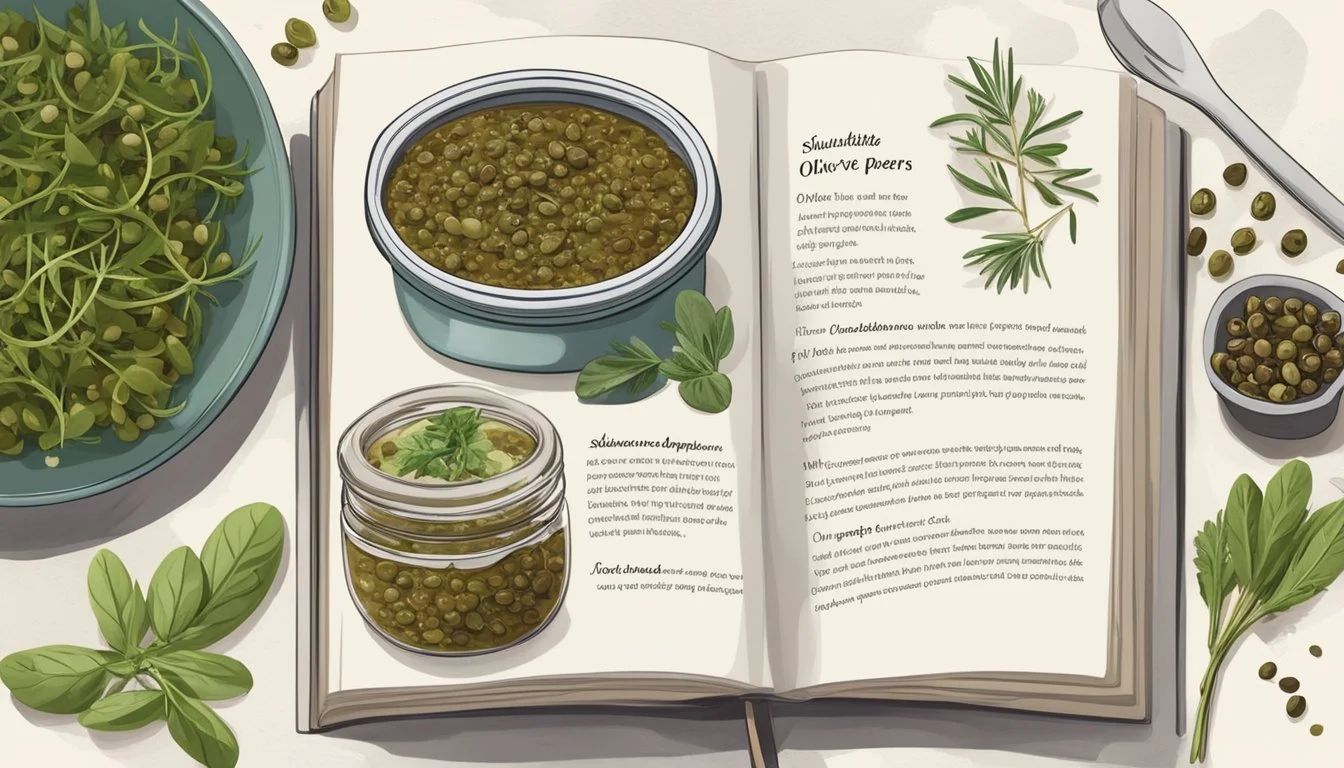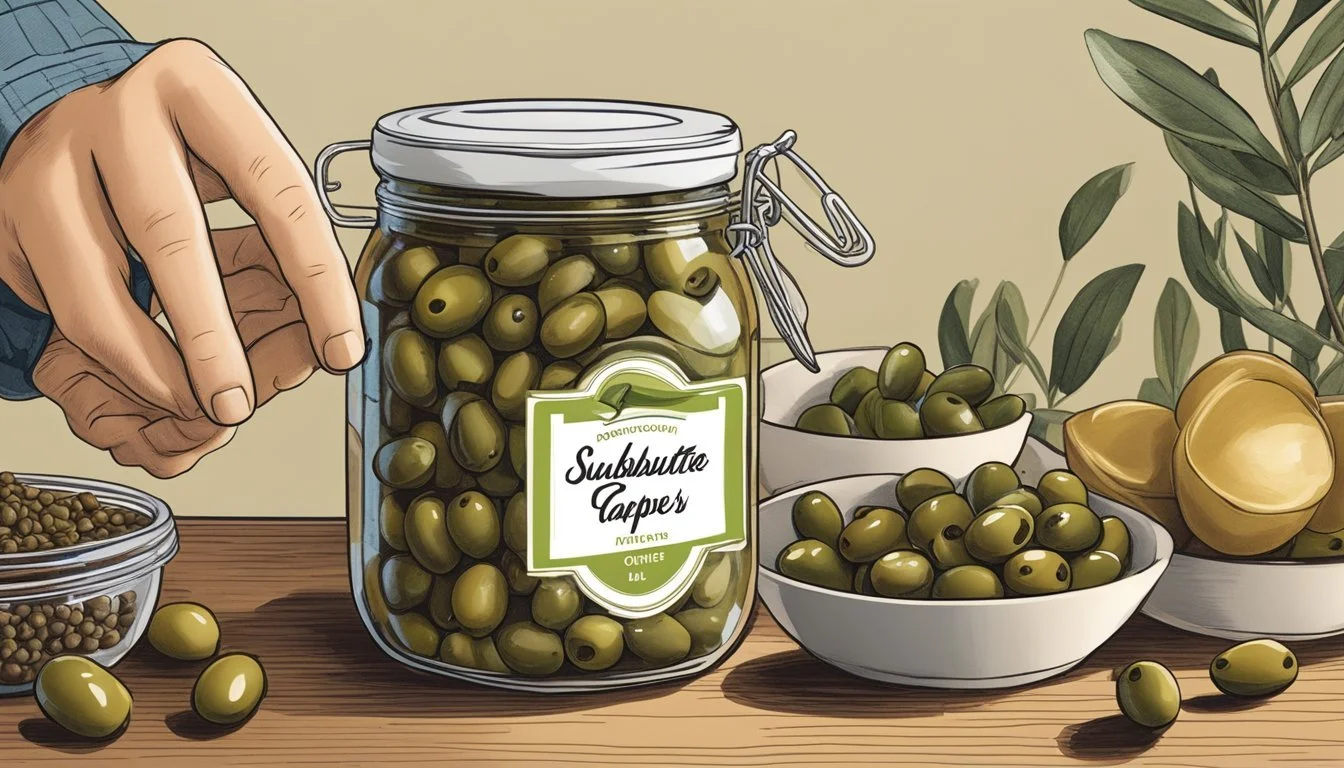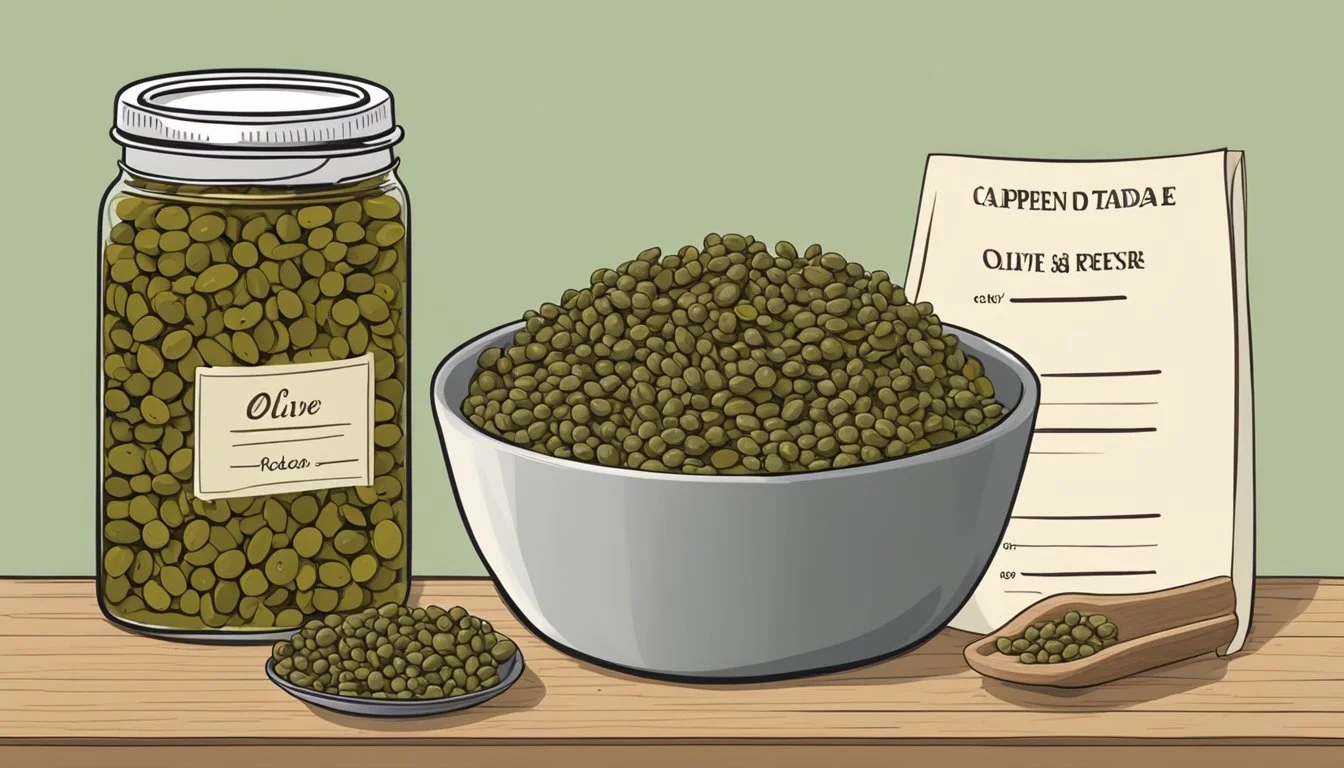How to Substitute Olive Tapenade for Capers in Recipes
A Simple Guide
Olive tapenade, with its briny and vibrant flavor profile, presents a versatile substitute for capers (What wine goes well with capers?) in various recipes. The tapenade, a blend primarily composed of olives, (What wine goes well with olives?) capers, and anchovies, (What wine goes well with anchovies?) echoes the piquant and salty characteristics of capers, albeit with a more complex texture and taste. The richness of olives in the tapenade can enhance dishes, providing a similar burst of Mediterranean flavor that one expects from capers.
In the culinary world, finding substitutes for specific ingredients is a common practice, especially when dealing with items that have distinctive tastes. Capers are known for adding a salty and acidic punch to dishes, and while not identical, olive tapenade can impart a comparable flavor. Chefs and home cooks often look for such swaps to either cater to availability of ingredients or to introduce a new dimension to traditional recipes.
When incorporating olive tapenade as a substitute for capers, the key is to consider the potency of flavors. Tapenade tends to have a more pronounced olive taste and a smoother, paste-like consistency compared to the small, firm capers. This difference should be acknowledged to ensure the final dish achieves the desired balance of flavors without overpowering other components in the recipe.
Understanding Olive Tapenade and Capers
Olive tapenade is a versatile condiment traditionally rooted in Mediterranean cuisine. It is a thick paste which gains its robust flavor from its primary ingredients: olives, capers, and anchovies. With its origins in the Provence region of France, tapenade carries a savory blend of salinity and herbed notes.
In contrast, capres, the small, green flower buds harvested from the caper bush, provide a distinct burst of flavor. They are known for their intense salt and vinegar profile, which can add a bright, tangy punch to dishes. Their size ranges from tiny nonpareil varieties to larger grained capers.
Texture plays a significant role when substituting olive tapenade for capers. Tapenade offers a more spreadable consistency due to the finely chopped or pureed mixture. This texture can influence the feel of a dish compared to the individual bite of a caper.
Ingredient Flavor Profile Texture Uses in Cuisine Olive Tapenade Savory, briny, with a hint of herbs Thick, spreadable Spread, condiment, dip Capers Salty, tangy, vinegary Firm, individual Garnish, flavor accent
When incorporating olive tapenade in recipes as a substitute for capers, one must consider the balance of Mediterranean flavors. Tapenade can effectively replace the brininess that capers provide. However, the substitution will also introduce the additional complexity of olives and anchovies. Adjustments may be required to achieve the desired end result in taste and texture.
Culinary Uses of Capers and Olive Tapenade
Capers and olive tapenade are versatile ingredients that can elevate the flavors of various dishes. Their salinity and brininess are particularly effective in appetizers and main dishes, and tapenade serves as a robust sandwich spread.
Incorporating Tapenade Into Appetizers
The bold flavor of olive tapenade makes it an excellent addition to appetizers. Tapenade can be mixed with hummus or spread directly on crostini or pita bread, and it pairs well with crisp vegetables like carrots and celery. The addition of arugula on top introduces a peppery note that complements the tapenade's richness.
Examples of Tapenade Appetizers:
Tapenade and hummus on pita with arugula
Tapenade spread on various crackers and bread
Fresh vegetables dipped in tapenade
Enhancing Main Dishes
Olive tapenade can significantly enhance the flavor profile of main dishes. It works exceptionally well alongside or mixed into pastas, polenta, or gnocchi, creating a Mediterranean twist. The umami depth of tapenade also makes it suitable for stuffing into portobello mushrooms, matching their meaty texture.
Ways to Enhance Main Dishes:
Mix tapenade with tomato sauce for pasta
Stuff tapenade into mushrooms
Use tapenade to top off polenta or gnocchi
Tapenade as a Sandwich Spread
As a sandwich spread, olive tapenade brings moisture and a medley of flavors that can turn a simple sandwich into a gourmet experience. It pairs well with a variety of ingredients, from cold cuts to cheeses and roasted vegetables. Using it in place of mayonnaise or mustard can add a new dimension of taste to the classic sandwich.
Sandwich Ideas Using Tapenade:
Roast beef sandwich with a layer of olive tapenade
Grilled vegetable sandwich enhanced with tapenade
Cheese and tapenade on a crusty bread sandwich
Substituting Olive Tapenade for Capers
When replacing capers with olive tapenade in recipes, one should pay close attention to the dish's overall flavor balance and texture. The substitution will depend on whether the dish is pasta, fish, or salad, and adjustments may need to be made to the amount of salt, acidity, and ingredients to maintain the dish's intended profile.
Adjusting Saltiness and Acidity
Olive tapenade tends to have a high salt content due to the brined olives, so reducing additional salt in the recipe is typically necessary. To mimic capers' acidity, adding lemon juice to the tapenade can provide the needed tartness. One should taste and adjust the tapenade mixture before adding it to the dish, looking for a balance between the salty, briny flavor of the olives and the bright, tangy zip from the lemon juice.
For pasta and fish: A ratio of one teaspoon of lemon juice per three tablespoons of tapenade can be a good starting point.
For salads: Lemon juice can be incorporated into the dressing to offset the tapenade's saltiness.
Matching Textures in Recipes
Olive tapenade's texture is more paste-like compared to the individual caper berries, which can affect the final feel of the dish. For dishes where capers provide a distinctive pop in texture, such as salads or textured toppings, one should chop the tapenade roughly to create small chunks rather than a smooth paste.
For pasta: Mixing chopped tapenade through the sauce maintains the bite.
For fish: A dollop of tapenade served on top can add a creamy contrast.
For salads: Incorporating small chunks within the salad ensures bursts of flavor without overwhelming the other ingredients.
Considerations for Vegan and Vegetarian Dishes
Olive tapenade works well as a caper substitute in vegan and vegetarian dishes (What wine goes well with vegetarian dishes?), provided one verifies all included ingredients align with dietary preferences. Some tapenades include anchovies, which are not vegan or vegetarian-friendly. It is essential to either find a version without anchovies or make a homemade tapenade using olives, capers, olive oil, and seasonings like pepper to fit the requirements.
Check labels carefully for non-vegan ingredients.
For homemade tapenade: Use pitted olives, a touch of capers, olive oil, and season with black pepper to taste.
Selecting the Right Type of Olives
When substituting olive tapenade for capers in recipes, the choice of olives is fundamental. Capers deliver a distinct tanginess and saltiness, which means the selected olives should provide a similar flavor profile to maintain the integrity of the dish.
Kalamata olives are a popular choice; their deep purple hue and fruity, earthy flavor can replicate the capers' strong taste. They bring a similar pungency which is crucial for dishes relying on these bold Mediterranean flavors.
In contrast, green olives are often milder and less bitter than Kalamata, providing a different aspect of brightness to dishes. Varieties like Castelvetrano olives are known for their buttery, smooth taste, which can enhance recipes without overwhelming other ingredients.
Black olives are more versatile due to their milder flavor profile. While they still impart a rich olive taste, they won't dominate the flavor of the dish and can be used generously.
For those seeking variety, Picholine olives offer a crisp texture and a slightly nutty flavor. Niçoise olives, on the other hand, are small, firm, and pack a savory punch, making them suitable for recipes where capers' boldness is essential.
Here's a quick guide to olive types and their flavors:
Olive Type Flavor Characteristics Kalamata Fruity, earthy, and pungent Green Olives Mild, bright Castelvetrano Buttery, smooth Black Olives Mild, rich Picholine Crisp, nutty Niçoise Savory, firm, and slightly bitter
When substituting, it's important to consider the final flavor and texture intended for the dish. Each olive variety brings a unique element, so chefs should select accordingly, ensuring their choice complements other ingredients and the overall essence of the recipe.
Making Olive Tapenade at Home
Creating olive tapenade at home is a straightforward process. One can easily blend the bold flavors of olives with a few staple ingredients using simple kitchen tools.
Essentials Tools and Ingredients
Tools: A food processor or a blender is crucial for achieving the right texture in the tapenade.
Ingredients:
Olives: The star of the tapenade, typically green or kalamata.
Olive oil: For a smooth consistency and rich flavor.
Garlic: Adds sharp depth.
Lemon juice: Provides acidity to balance the flavors.
Fresh parsley or thyme: Introduces a herbaceous note.
Step-by-Step Preparation
Combine Ingredients: In the food processor, add 1 cup of pitted olives, 1-2 cloves of garlic, the juice of half a lemon, and a handful of fresh parsley or a teaspoon of thyme.
Pulse: Briefly pulse the mixture about 10 times, then scrape down the sides.
Add Oil: With the processor running, drizzle in 2-3 tablespoons of olive oil.
Texture: Continue to pulse until the mixture is well chopped but not pureed.
Taste: Adjust the seasoning, adding more lemon juice or herbs to suit your palate.
Storage and Preservation
Storage: Transfer the tapenade into an airtight container and store it in the refrigerator.
Make Ahead: This tapenade can be made ahead of time, allowing flavors to meld.
Shelf Life: Properly stored, it can last for up to one week.
Expert Tips for Using Olive Tapenade as a Substitute
When substituting olive tapenade for capers, one must consider the intensity of flavors and how this richer condiment interacts with the overall recipe. The goal is to achieve a harmonious balance while leveraging the tapenade's complexity to enhance the dish.
Adjusting Recipes for Balance
Salt Content: Olive tapenade is saltier than capers; therefore, reduce any added salt from the recipe to avoid overpowering the dish.
Acidity: Capers have a distinct tang that can be mimicked by adding a squeeze of lemon juice or a splash of vinegar to the tapenade.
Texture: If the texture of capers is crucial, chop the tapenade to a similar caper-like size.
Spices: To align the tapenade more closely with capers’ flavor, consider adding a pinch of black pepper or red pepper flakes for heat.
Creative Serving Suggestions
Serving: Utilize tapenade as a dynamic topping on a charcuterie (What wine goes well with charcuterie?) board, pairing with cheeses and cured meats (What wine goes well with cured meats?) to complement its boldness.
Dips and Spreads: When mixed with extra virgin olive oil, tapenade can become a dip for bread or a spread for sandwiches (What wine goes well with sandwiches?), replacing capers with a more textured element.
Zest Enhancement: Finish the tapenade with a sprinkle of lemon zest to introduce a bright note and a pop of color to the dish.
Dietary Considerations and Allergies
When substituting olive tapenade for capers in recipes, it’s important to consider specific dietary restrictions and known allergens to ensure the dish remains suitable for everyone's needs.
Gluten-Free and Dairy-Free Options
Gluten-Free: Olive tapenade is inherently gluten-free, as it primarily consists of chopped olives, capers, olive oil, and seasonings. It's crucial to check that any added ingredients, such as anchovy paste, do not contain gluten or are processed in a facility with gluten-rich products.
Dairy-Free: Traditional olive tapenade does not include dairy products. However, always verify the labels of store-bought tapenades or ensure no dairy-derived ingredients have been added in homemade versions.
Identifying Potential Allergens
Fish Allergens: For individuals allergic to fish, it’s essential to note that some olive tapenade recipes include anchovy paste. One should opt for a variant without anchovy or use another substitute that aligns with their dietary needs.
Other Allergens: While tapenade and capers themselves are unlikely to cause allergic reactions, it's always important to consider cross-contamination or the presence of other allergens in packaged versions. Reading labels and inquiring about food preparation practices can mitigate the risk of allergic reactions.
Pairing with Other Mediterranean Ingredients
The substitution of olive tapenade for capers in recipes opens the door to diverse combinations with Mediterranean staples. Understanding how to blend tapenade's rich, briny profile with compatible flavors and textures is essential.
Complementary Flavors and Textures
Olive Tapenade: Ideal as a caper substitute, it offers a similar saltiness and richness. The robust flavor of black olive tapenade pairs especially well with the creamy savoriness of hummus.
Hummus: The creaminess contrasts tapenade's coarse texture, enhancing both elements.
Pesto: The herby, garlicky taste complements the punchy profile of tapenade.
Sun-dried Tomatoes and Artichoke Hearts: They lend a sweet and tangy flavor that balances the salty depth of tapenade.
Artichoke Hearts: Their tender bite pairs with the chunky consistency of tapenade.
Roasted Red Peppers: The sweetness and smokiness work with tapenade's savory notes, ideal in grain salads or as a topping on grilled fish.
Innovative Combinations for Tapenades
Experimenting with tapenade in recipes encourages innovative fusion with other Mediterranean components, resulting in novel flavors that invigorate classic dishes.
Balsamic Vinegar: A drizzle can brighten the tapenade's flavor, offering an acid counterpoint that can enliven bruschettas or appetizers.
Tapenade in Pasta: A dollop in place of traditional sauces can introduce a unique twist to pasta dishes, whether used with sun-dried tomatoes for a vibrant sauce or mixed with pesto for a more complex flavor profile.
Integrating tapenade with Mediterranean ingredients not only enhances the taste but also adds a textural contrast that can elevate the overall dining experience.
Conclusion
When culinary enthusiasts seek to enrich their dishes with complex flavors, substituting olive tapenade for capers is a commendable strategy. This substitution allows for confident experimentation, ensuring that chefs can adapt their favorite recipes with ease. The key constituents of olive tapenade—olives, anchovies, garlic, and lemon juice—provide a flavor profile that echoes the briny, tangy qualities capers impart to a dish.
Best Practices:
Quantity: Use olive tapenade in a 1:1 ratio when replacing capers.
Texture: Finely chop or blend tapenade for a texture that mimics finely chopped capers.
Saltiness: Adjust salt in the recipe, as tapenade contains olives, which are naturally salty.
For recipes that demand an acidic burst, chefs may introduce additional lemon juice to the tapenade to closely emulate capers’ sharpness. It is worth noting that while tapenade can be a suitable substitute, some nuanced flavors unique to capers might not be fully replicated. This distinction should be embraced as part of the culinary adventure.
In conclusion, with a well-prepared olive tapenade, individuals can approach recipe modification with both creativity and confidence. The end result will be dishes infused with rich, layered flavors, delivering satisfaction to any palate.









